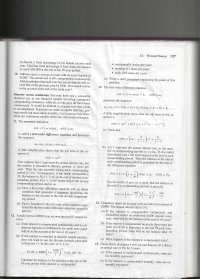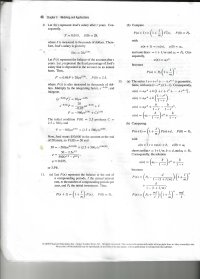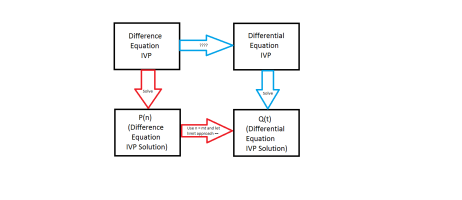I am interested in Exercise 12 from Section 3.3 of Differential Equations With Boundary Value Problems by Polking, Boggess, and Arnold...

Exercise 12 references Exercise 11, to which the official solution is...

Exercise 12 part (a) is straightforward; solve [imath]\frac{dQ}{dt} = .06Q,\ Q(0) = 2000, Q(10) =[/imath] the solution, which turns out as [imath]\$3644.24[/imath].
I think the point of this problem requested by part (c) is that the solutions to the difference equations at the [imath]10[/imath] year point are supposed to monotonically increase as we increase [imath]m[/imath], and converge to the differential equation solution as [imath]m[/imath] approaches [imath]\infty[/imath]. Since there's nothing special about the [imath]10[/imath] year point, we can be slightly more ambitious and expect the entire particular solution curve to converge as such.
I'm just a bit stuck on how to get there by following part (b). The formula generated in Exercise 11, [imath]P(n) = 2000(1 + \frac{.06}{m})^n[/imath], doesn't converge to the differential equation solution [imath]Q(t) = 2000e^{.06t}[/imath] for large [imath]m[/imath], but [imath]P[n] = 2000(1 + \frac{.06}{m})^{mn}[/imath] does, so I think I need to get an extra [imath]m[/imath] into the exponent.
I could apply the substitution [imath]t = \frac{n}{m}[/imath], [imath]Q(t) = P(n)[/imath] to the difference equation solution to get it into the right form, but this feels superficial; the substitution would never be undone, and I could just as easily make any substitution to get almost any desired answer.
What else can I do to introduce this missing [imath]m[/imath] in a careful fashion?

Exercise 12 references Exercise 11, to which the official solution is...

Exercise 12 part (a) is straightforward; solve [imath]\frac{dQ}{dt} = .06Q,\ Q(0) = 2000, Q(10) =[/imath] the solution, which turns out as [imath]\$3644.24[/imath].
I think the point of this problem requested by part (c) is that the solutions to the difference equations at the [imath]10[/imath] year point are supposed to monotonically increase as we increase [imath]m[/imath], and converge to the differential equation solution as [imath]m[/imath] approaches [imath]\infty[/imath]. Since there's nothing special about the [imath]10[/imath] year point, we can be slightly more ambitious and expect the entire particular solution curve to converge as such.
I'm just a bit stuck on how to get there by following part (b). The formula generated in Exercise 11, [imath]P(n) = 2000(1 + \frac{.06}{m})^n[/imath], doesn't converge to the differential equation solution [imath]Q(t) = 2000e^{.06t}[/imath] for large [imath]m[/imath], but [imath]P[n] = 2000(1 + \frac{.06}{m})^{mn}[/imath] does, so I think I need to get an extra [imath]m[/imath] into the exponent.
I could apply the substitution [imath]t = \frac{n}{m}[/imath], [imath]Q(t) = P(n)[/imath] to the difference equation solution to get it into the right form, but this feels superficial; the substitution would never be undone, and I could just as easily make any substitution to get almost any desired answer.
What else can I do to introduce this missing [imath]m[/imath] in a careful fashion?

